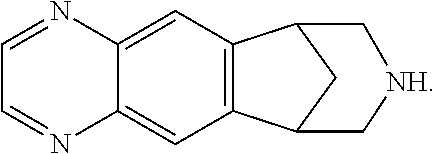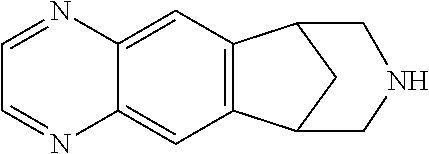Transdermal system for varenicline
a varenicline and transdermal technology, applied in the field of pharmaceutical compositions, can solve the problems of varenicline's reactivity with the excipient itself or with trace impurities (i.e., degradants) of the excipients, and achieve the effect of improving the reactivity of varenicline and reducing the toxicity of vareniclin
- Summary
- Abstract
- Description
- Claims
- Application Information
AI Technical Summary
Benefits of technology
Problems solved by technology
Method used
Image
Examples
example 1
[0047]As a way of measuring the skin permeation properties of active ingredient, a Franz diffusion cell was provided utilizing a human cadaver skin membrane and a receptor fluid such as 1.0M phosphate buffered saline. The receptor compartment of the Franz diffusion cell was filled with the receptor fluid and the diffusion cell was maintained at 34.5° C. Human cadaver skin was cut out to provide a membrane of 1.767 cm2 surface area. The amount of active ingredient that had permeated through the membrane by various times in a 6 to 48 hour period was determined by HPLC analysis of the receptor fluid. Each test was conducted in several replicates. The average calculated skin flux and average amount penetrating per square centimeter after 24 and 48 hours for Formulation I and II are shown in Table 1. These experimental results using the Franz diffusion cell methodology indicate that transdermal delivery of this compound is feasible based on theoretical skin fluxes for the active ingredie...
example 2
Matrix Type Transdermal
[0054]The active ingredient is mixed with the aqueous dispersion of NACOR 72-9965 (hydrophobic acrylic copolymer from National Starch) to achieve a 2% (w / w) concentration of active ingredient in the dried film after film casting. The adhesive mixture is cast on a release coated polymer film (Rexam Release Technologies; W. Chicago, Ill.) and is dried at 60° C. in a convective oven and cut to achieve a 2 mgA dose of the active ingredient. The dried film is laminated to a polyester film laminate (SCOTCHPACK #1012, 3M Pharmaceuticals; St. Paul, Minn.).
example 3
Matrix Type Transdermal Systems
[0055](1) The base form or salt forms of the active ingredient is dissolved or dispersed in a polyacrylate solution, such as Duro-Tak® 387-2052 adhesive. Appropriate solvent, enhancer and / or filler is added in the adhesive dispersion, and mixed well. Air is removed from the resulting mixture and laminated on a release liner, such as Medirelease® 2228, to form a coating thickness of 0.5-2 mm. The adhesive layer is dried at room temperature for 5-10 min and then at 40-80° C. for 15-30 min to remove all volatile solvents. A backing sheet, such as Mediflex® 1200, is coated on the adhesive side. The resulting patches of a desired size are stored in sealed packages.
[0056](2) The base form or salt forms of the active ingredient is dissolved or dispersed in a polyisobutylene (PIB) based adhesive, such as Duro-Tak® 87-6173. The following procedures are similar to those described in the previous section.
[0057](3) The base form or salt forms of the active ingredi...
PUM
| Property | Measurement | Unit |
|---|---|---|
| thickness | aaaaa | aaaaa |
| temperature | aaaaa | aaaaa |
| temperature | aaaaa | aaaaa |
Abstract
Description
Claims
Application Information
 Login to View More
Login to View More - R&D
- Intellectual Property
- Life Sciences
- Materials
- Tech Scout
- Unparalleled Data Quality
- Higher Quality Content
- 60% Fewer Hallucinations
Browse by: Latest US Patents, China's latest patents, Technical Efficacy Thesaurus, Application Domain, Technology Topic, Popular Technical Reports.
© 2025 PatSnap. All rights reserved.Legal|Privacy policy|Modern Slavery Act Transparency Statement|Sitemap|About US| Contact US: help@patsnap.com


